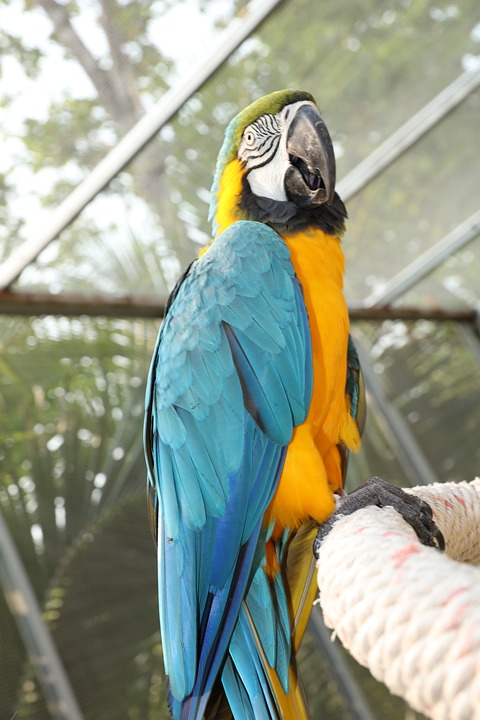Parrots are fascinating creatures known for their intelligence, vibrant plumage, and ability to mimic human speech. However, understanding their behavior can be a challenging task for pet owners. In this article, we will delve into the intricacies of parrot behavior, focusing specifically on how they respond to changing toy setups. By comprehending their reactions, you can ensure optimal mental stimulation and well-being for your feathered friend.
Toys play a crucial role in a parrot’s life, providing mental stimulation, preventing boredom and destructive behavior, and encouraging physical activity. Parrots are highly intelligent creatures that thrive on mental challenges. Toys help keep their minds active and engaged, preventing them from getting bored and resorting to destructive behaviors like feather plucking or excessive screaming. Furthermore, toys that promote physical activity, such as swings or climbing structures, help keep the parrot physically fit and healthy.
When it comes to changing toy setups, parrots typically exhibit a range of responses. Initially, they may show curiosity and explore the new toys. This can involve inspecting the toys, touching them with their beaks or claws, and even trying to dismantle them. Parrots are vocal creatures, and they often communicate their feelings through various vocalizations. When faced with new toys, they may vocalize differently, expressing excitement, curiosity, or even fear.
Playful behavior and engagement are positive signs that the parrot is enjoying the new toy setup. They may interact with the toys by chewing, swinging, or manipulating them with their beaks and claws. This playful engagement is not only enjoyable for the parrot but also provides mental and physical stimulation.
However, some parrots may exhibit destructive tendencies or aggression towards new toys. This can be due to instinctual territorial behavior, fear of the unfamiliar, or a dislike for certain textures or shapes. It is important to introduce new toys gradually, allowing the parrot to become familiar with them at its own pace. This can help alleviate any potential aggression or fear response.
Several factors influence parrot behavior when it comes to toys. Species-specific traits and natural instincts play a significant role. For example, larger parrot species may have a stronger instinct to chew and destroy toys, while smaller species may be more inclined towards foraging or manipulating objects. Individual personality and preferences also play a role, as each parrot is unique and may have different preferences for certain types of toys or activities. Additionally, past experiences and socialization can influence a parrot’s response to toys. A parrot that has had positive experiences with toys from an early age may be more receptive to new toy setups. Environmental enrichment and variety are also important factors. Providing a variety of toys with different textures, shapes, and colors can keep the parrot engaged and prevent boredom.
When introducing new toys, there are some tips to keep in mind. Gradual introduction and observation are essential to gauge the parrot’s response and make any necessary adjustments. Incorporating different textures, shapes, and colors can cater to the parrot’s preferences and provide a varied and stimulating environment. Rotating toys regularly ensures that the parrot doesn’t get bored and maintains interest in its toy collection. However, always prioritize safety and supervise the parrot when playing with toys to prevent any accidents or injuries.
To address common concerns, here are some frequently asked questions:
Q1: Why does my parrot become aggressive when I introduce a new toy?
A: Parrots may exhibit aggression when faced with unfamiliar objects due to instinctual territorial behavior or fear. It is essential to introduce new toys gradually, allowing the parrot to become familiar with them at its own pace.
Q2: How can I encourage my parrot to interact with new toys?
A: Try incorporating toys that cater to your parrot’s natural instincts, such as foraging toys or puzzle toys. Additionally, demonstrating playfulness and engaging with the toys yourself can pique your parrot’s curiosity and encourage interaction.
Q3: Can I reuse old toys or should I always provide new ones?
A: Parrots can often enjoy the familiarity of their favorite toys. It is beneficial to rotate toys periodically, providing a mix of familiar and new items to prevent boredom. However, ensure that the toys are still in good condition and free from any potential hazards.
Q4: Is it normal for my parrot to show no interest in toys at all?
A: While some parrots may naturally be less inclined to play with toys, a complete disinterest in toys could indicate a lack of mental stimulation. Experiment with different types of toys, textures, and activities to find what captures your parrot’s attention and engages its curiosity.
Q5: How often should I change my parrot’s toy setup?
A: Regularly changing your parrot’s toy setup is essential to prevent boredom. Aim to introduce new toys or rearrange existing ones every few weeks. However, observe your parrot’s response to the changes to ensure it is not causing undue stress or anxiety.
In conclusion, understanding parrot behavior, particularly their responses to changing toy setups, is crucial for providing a stimulating and enriching environment for your feathered companion. By considering the factors that influence their behavior, introducing new toys gradually, and incorporating variety, you can promote a happy and mentally engaged parrot. Remember to observe and adapt to your parrot’s preferences, ensuring a harmonious relationship between your pet and its toys.









